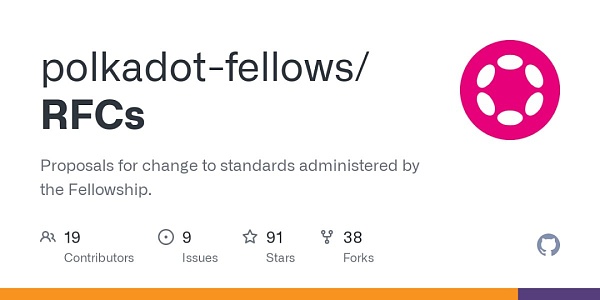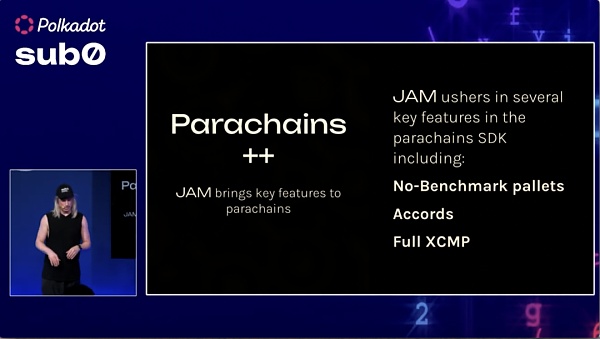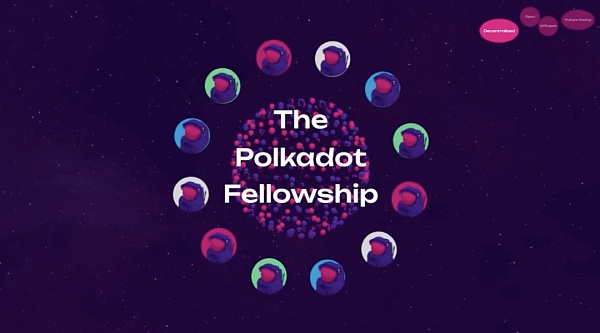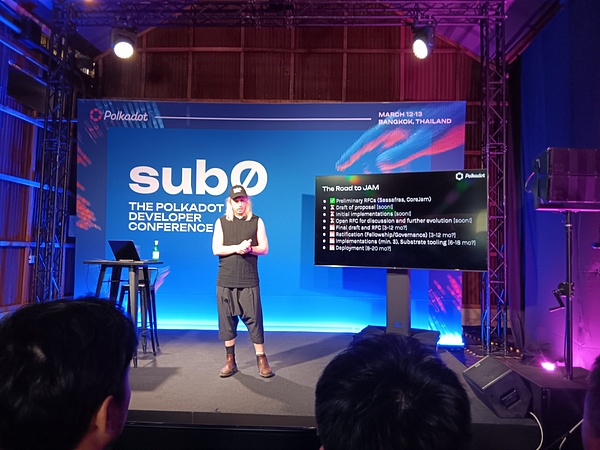First of all, the JAM chain is not a smart contract chain. Itsdesign focus is on handling rollups rather than performing complex calculations itself - rollups are a technology designed to make the chain more efficient and scalable. The design of the JAM chainallows for very flexible calculations, but these calculations are performed under specific conditions, which is very different from the general calculation model of smart contract chains.
One of the design goals of the JAM chain is high throughput and low latency. It is designed tohandle high volumes of transactions and keep processing times short. At the same time, JAM chain also focuses onreliability and security. Although it consumes relatively little energy, maintaining a high degree of safety when handling rollups is one of the key features of its design.
Preliminary RFC (Sassafras, CoreJam )
Draft proposal (to be released soon)
Initial implementation (coming soon)
Open RFC for discussion and further evolution (coming soon)
Final draft and RFC (3-12 months)
Recognition (Fellowship/Governance) (3-12 months)
Implementation (at least three), Substrate Tools (6-18 months)
Deployment (8-20 months)
In general, the JAM chain is not a traditional smart contract network and has no concept of transactions. All work items (work items) on the JAM chain network will first be packaged into work packages and other generation operations, and will go through three parts of processing, namely refining (refine), accumulation ( accumulate) and transfer (on transfer)package work items and then reintegrate them to improve computing efficiency. Anyone can create a service on the JAM chain. A service refers to a certain operational process, similar to the smart contract concept of the EVM network. Creating a service model requires specific formats and inputs.
Multi-core world computerProvides a more free and flexible development experience
If you want to learn more about JAM, check out the CoreJam draft RFC. It is important to note that this is a first draft and many technical details have changed. There will be a new draft RFC released regarding JAM. ? https://github.com/polkadot-fellows/RFCs/pull/31
In Bryan Chen’s opinion, the most interesting thing about JAM is thatIt abstracts away the blockchain portion of the decentralized stack, essentially providing a world computer with multiple cores that can execute arbitrary programs or services.

Reorganize Polkadot relay chain components
Polkadot relay chain is composed of different components , JAM actually reconstructs this architecture and exposes basic components, allowing developers to use these basic components to build a variety of services, including general DA services Not just the current ability to build parachains.
By using JAM, developers can run parachain services to build more decentralized and secure blockchains. But building a decentralized blockchain is just one of many applications of JAM. Developers can also use JAM to develop more interesting applications. Data Availability (DA) is a good example, but it is not an innovative revolution.
At the same time, developers can deploy various services on JAM, one of which can be Parachain Service, that is, through JAM to build a parachain or blockchain; but developers can also deploy a Chainless EVM Service on JAM, which is a service without a chain. An example is Contract Wallet .
Chainless decentralized applications
Bryan also shared The change that a JAM may bring is Chainless DApp (chainless decentralized application). This means that every decentralized application (DApps) that requires computing power runs on a blockchain or similar platform. However, with the introduction of JAM,decentralized applications can perform computing tasks without relying on traditional blockchains, that is, Chainless Dapps.
In the Web2 world, Ethereum, or most independent blockchain networks, are basically servers hosted in someone's basement. Polkadot provides a solution similar to cloud computing, where people can rent an instance for a period of time to run their own blockchain,while enjoying the shared security provided by the Polkadot network.
Polkadot 2.0 goes a step further, providing a serverless solution. Developers no longer need to worry about servers. Applications can run somewhere in the cloud on request and are equally protected by shared security.
Before the emergence of Serverless, cloud services were very simple, just renting machines and deploying services on them. Then he is responsible for maintaining the machine, upgrading the system, and applying patches, but there is a relatively high maintenance cost. The same is true for current parallel chain development. Developers have to spend a lot of energy on maintaining the chain, and the cost of upgrading Polkadot-sdk is relatively high.
The concept of Serverless is that developers only need to write business logic and do not need to maintain machines and do not want to think about load balancing, scale up/down and other things. JAM allows protocol developers to develop a function similar to AWS lambda, reducing application developers’ maintenance costs. For developers, there is no concept of a server.
Most of the advantages of serverless applications also apply to chainless DApps. They are highly scalable because multiple copies of an application can be run on multiple cores at the same time. In addition, such an application can be very cheap because it only consumes resources when it is used rather than running continuously, thusreducing costs. Operational costs are also significantly reduced, as servers (blockchain) no longer need to be maintained. The maintainer that executes the runtime, known as the JAM service, handles all operational work such as upgrading and implementing new features.
Serverless technology has revolutionized the way some cloud applications are developed. JAM will bring about similar changes. However, it should be noted that not all modern cloud applications adopt serverless architecture, and traditional servers still occupy an important position. The same applies to parachain technology, whichstill has its own technical advantages.
Building a future with unlimited potential
JAM’s growth doesn’t stop here. JAM provides a very interesting model and many primitiveswith great potential. Bryan believes that more modern decentralized applications with different models will be discovered in the future. Essentially,JAM aims to remove some of the existing limitations and provide developers with more freedom and flexibility compared to Polkadot 1.0.

Different JAM The ability to synchronous messaging between apps also cannot be ignored. This is something Web2 apps cannot do, as they typically rely on the server to handle messaging rather than direct synchronous communication between apps. This feature provides more possibilities for interaction and collaboration among decentralized applications.
In the Web2 world, asynchronous requests have been solved to a large extent. However,Asynchronous requests add a lot of complexity and introduce many bugs. Some common problems include "callback hell" (callback hell, where multiple levels of nested callback functions make code difficult to understand and maintain) and "race conditions"< /strong>(race conditions, where multiple concurrent operations lead to unpredictable results). We are starting to observe these issues in today’s cross-chain messaging protocols. But with the introduction of JAM, this may no longer be an issue.
JAM is still in its very early stages and more work needs to be done to make it operational. If you want to learn about the JAM RFC as soon as it is released, please pay attention to theFellowship RFC library:
https://github. com/polkadot-fellows/RFCs

If you want to get more involved and contribute to JAM, Bryan recommends that developers join the Core Fellowship to learn more about technical updates.
JAM chain will become Polkadot 2.0 A new paradigm
Gavin mentioned in his speech that Polkadot 2.0 may not be launched in an iterative and gradual manner, but on a large scale in a one-time manner. The underlying consensus of Polkadot 2.0 is currently being gradually formed, and will not be upgraded in a fork-free manner in the future. And theJAM chain is a new paradigm that will be introduced in Polkadot 2.0. TheJam chain will be the foundation of Polkadot 2.0, providingmulti-core computing for blockchains like Polkadot and supporting hundreds of chainsand even moresmart contracts, ZK-rollups etc.
In Polkadot 2.0,smart contracts no longer require benchmarks, Accords, XCMP! Polkadot 2.0 will support backward compatibility, with immediate support for all Polkadot 1.0s. At the same time, Agile Coretime is not part of Polkadot 2.0, but it is already under construction and allows more flexible use of existing cores.
The JAM chain mentioned above will be a simpler, fixed protocol, which means that its core rules and mechanisms will not be frequently used change. Because the JAM protocol is fixed, developers can build different clients based on JAM without always having to chase the latest version of Substrate's client. Although the JAM protocol is fixed,Substrate can still run on parachains and system chains, and developers can still use Substrate to develop and deploy their blockchain applications.

According to Gavin’s introduction, others Updates about Polkadot 2.0 also include that DOT will become an important part of the JAM architecture, and in the JAM architecture, Polkadot's governance mechanism will no longer directly control the issuance of tokens. Instead, this responsibility will be determined by the JAM Agreement itself. This is a significant change that could impact the governance and economic model of the Polkadot network.
Conclusion
In In this speech at the sub0 conference, we saw Gavin Wood's vision for the future JAM chain and Polkadot 2.0 and his full grasp of technological development.
JAM chain, as a new blockchain concept, will bringmulti-core computing capabilities, efficient processing mechanisms and more flexibility to the Polkadot ecosystem. Application Scenarios. Unlike traditional smart contract chains, the JAM chain focuses onprocessing rollups, maintaining high throughput and low latency, while providing a safer and more reliable execution mechanism.
We look forward to new technologies supporting smart contracts, Accords, XCMP and other functions during the emergence of Polkadot 2.0. These changes will promote the continuous development of the Polkadot ecosystem. Develop and improve to provide users with more efficient, secure and flexible Web3 solutions.
< mp-style-type>
 JinseFinance
JinseFinance
 JinseFinance
JinseFinance JinseFinance
JinseFinance JinseFinance
JinseFinance JinseFinance
JinseFinance JinseFinance
JinseFinance Sanya
Sanya Olive
Olive Cointelegraph
Cointelegraph Cointelegraph
Cointelegraph Cointelegraph
Cointelegraph